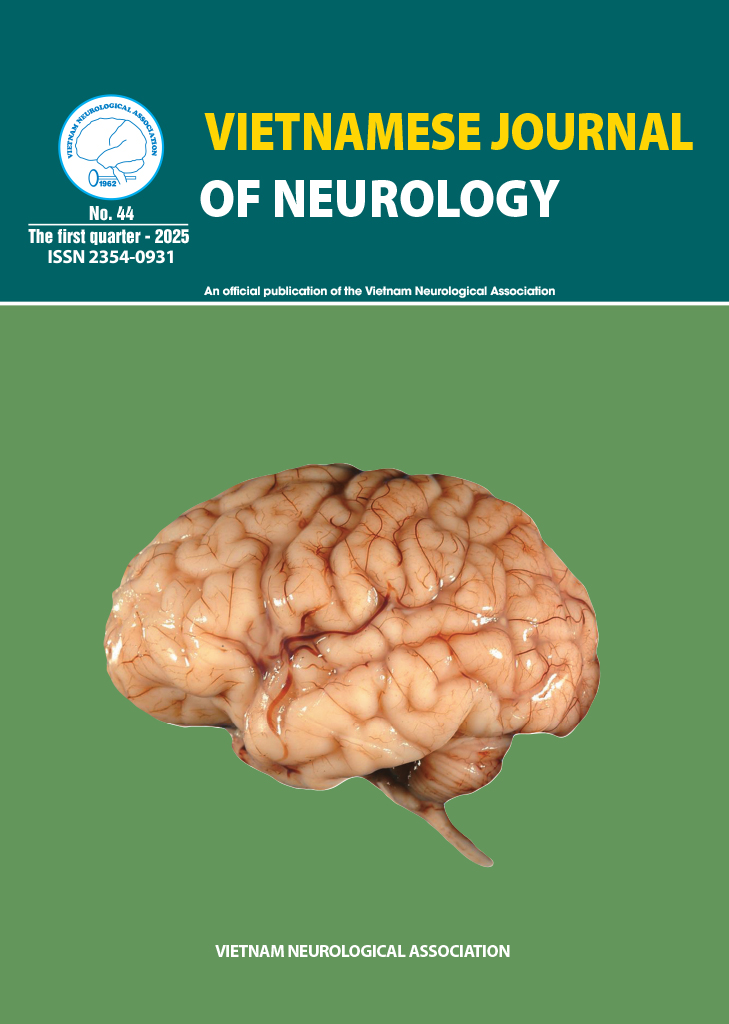Xác định tỷ lệ xuất hiện tình trạng xấu đi về mặt lâm sàng và các yếu tố liên quan ở người bệnh sau khi rời khỏi phòng hồi sức tích cực

DOI:
https://doi.org/10.62511/vjn.44.2025.043Từ khóa:
suy giảm lâm sàng người bệnh hồi sức xuất ICU yếu tố liên quanLượt tải xuống
Đã xuất bản
Số tạp chí
Chuyên mục
Thể loại
Cách trích dẫn
Tóm tắt
Mục tiêu: Xác định tỉ lệ xuất hiện tình trạng xấu đi về mặt lâm sàng và các yếu tố liên quan ở người bệnh sau khi rời khỏi phòng hồi sức Khoa Nội – Hồi sức Thần kinh, Bệnh viện Hữu Nghị Việt Đức
Phương pháp: Nghiên cứu cắt ngang được thực hiện từ 01/2024 đến 10/2024. Tình trạng xấu đi về mặt lâm sàng được xác định khi có xuất hiện các dấu hiệu như suy hô hấp: cần đặt NKQ/MKQ, thở máy, điều trị oxy lưu lượng cao; sốc tuần hoàn: tụt huyết áp cần thuốc vận mạch hoặc co mạch; chuyển lại phòng ICU trong vòng 96h sau khi rời khỏi ICU
Kết quả: Tổng số 147 người bệnh được lựa chọn tham gia vào nghiên cứu, Trong đó, tỉ lệ người bệnh có tình trạng xấu đi về mặt lâm sàng sau khi rời khỏi ICU là 10,2% (15 bệnh nhân), đa số xảy ra trong vòng 48h đầu (83,33%). Nguyên nhân nhập ICU, hình thức xuất ICU, sử dụng vận mạch khi xuất ICU, điểm NEWS, NEWSC, và HEWS lúc xuất ICU của người bệnh có liên quan có ý nghĩa thống kê với tình trạng xuất hiện suy giảm lâm sàng sớm (p < 0,05).
Kết luận: Tình trạng xấu đi sớm trên lâm sàng sẽ làm tăng chi phí cũng như một số biến chứng mắc phải tại bệnh viện. Do đó để nâng cao kết quả chăm sóc bệnh nhân, hạn chế tình trạng xuất hiện xấu đi sớm trên lâm sàng thì việc đào tạo cho nhân viên y tế đặc biệt là đối tượng điều dưỡng ICU để họ có thể phát hiện được những bệnh nhân có nguy cơ cao sẽ giúp làm giảm tỉ lệ người bệnh xuất hiện tình trạng xấu đi sớm trên lâm sàng sau khi rời khỏi ICU
Tài liệu tham khảo
Halpern. N.A.. et al.. Critical care medicine in the United States: addressing the intensivist shortage and image of the specialty. Crit Care Med. 2013. 41(12): p. 2754-61.
DOI: https://doi.org/10.1097/CCM.0b013e318298a6fb

Wong. E.G.. et al.. Association of severity of illness and intensive care unit readmission: A systematic review. Heart Lung. 2016. 45(1): p. 3-9.e2.
DOI: https://doi.org/10.1016/j.hrtlng.2015.10.040

Uppanisakorn. S.. et al.. National Early Warning Score (NEWS) at ICU discharge can predict early clinical deterioration after ICU transfer. J Crit Care. 2018. 43: p. 225-229.
DOI: https://doi.org/10.1016/j.jcrc.2017.09.008

Whittington. J.. et al.. Using an automated risk assessment report to identify patients at risk for clinical deterioration. Jt Comm J Qual Patient Saf. 2007. 33(9): p. 569-74.
DOI: https://doi.org/10.1016/S1553-7250(07)33061-4

Ponzoni. C.R.. et al.. Readmission to the Intensive Care Unit: Incidence. Risk Factors. Resource Use. and Outcomes. A Retrospective Cohort Study. Ann Am Thorac Soc. 2017. 14(8): p. 1312-1319.
DOI: https://doi.org/10.1513/AnnalsATS.201611-851OC

Garland. A.. et al.. Epidemiology of critically ill patients in intensive care units: a population-based observational study. Crit Care. 2013. 17(5): p. R212.
DOI: https://doi.org/10.1186/cc13026

Rosenberg. A.L. and C. Watts. Patients readmitted to ICUs* : a systematic review of risk factors and outcomes. Chest. 2000. 118(2): p. 492-502.
DOI: https://doi.org/10.1378/chest.118.2.492

Li. P.. H.T. Stelfox. and W.A. Ghali. A prospective observational study of physician handoff for intensive-care-unit-to-ward patient transfers. Am J Med. 2011. 124(9): p. 860-7.
DOI: https://doi.org/10.1016/j.amjmed.2011.04.027

Baker. D.R.. et al.. Patient flow variability and unplanned readmissions to an intensive care unit. Crit Care Med. 2009. 37(11): p. 2882-7.
DOI: https://doi.org/10.1097/CCM.0b013e3181b01caf

Araujo. T.G.. et al.. Readmissions and deaths following ICU discharge: a challenge for intensive care. Rev Bras Ter Intensiva. 2013. 25(1): p. 32-8.
DOI: https://doi.org/10.1590/S0103-507X2013000100007

Uppanisakorn. S.. et al.. National Early Warning Score (NEWS) at ICU discharge can predict early clinical deterioration after ICU transfer. Journal of Critical Care. 2018. 43: p. 225-229.
DOI: https://doi.org/10.1016/j.jcrc.2017.09.008

Zaidi. H.. M. Bader-El-Den. and J. McNicholas. Using the National Early Warning Score (NEWS/NEWS 2) in different Intensive Care Units (ICUs) to predict the discharge location of patients. BMC Public Health. 2019. 19(1): p. 1231.
DOI: https://doi.org/10.1186/s12889-019-7541-3

BHSc. B.T.. et al.. The Admission Hamilton Early Warning Score (HEWS) Predicts the Risk of Critical Event during Hospitalization. 2017. 11.
DOI: https://doi.org/10.22374/cjgim.v11i4.190

Feng. Y.. et al.. COVID-19 with Different Severities: A Multicenter Study of Clinical Features. Am J Respir Crit Care Med. 2020. 201(11): p. 1380-1388.
DOI: https://doi.org/10.1164/rccm.202002-0445OC

Klepstad. P.K.. et al.. Use of National Early Warning Score for observation for increased risk for clinical deterioration during post-ICU care at a surgical ward. Ther Clin Risk Manag. 2019. 15: p. 315-322.
DOI: https://doi.org/10.2147/TCRM.S192630

Doğu. C.. et al.. Importance of the National Early Warning Score (NEWS) at the time of discharge from the intensive care unit. Turk J Med Sci. 2020. 50(5): p. 1203-1209.
DOI: https://doi.org/10.3906/sag-1906-78

Jo. Y.S.. et al.. Readmission to medical intensive care units: risk factors and prediction. Yonsei Med J. 2015. 56(2): p. 543-9.
DOI: https://doi.org/10.3349/ymj.2015.56.2.543










